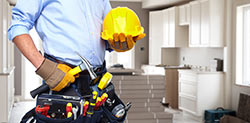For homeowners, it’s an endless struggle: You know that you could save money on monthly expenses if you were to renovate your home, but those renovations cost money. So, the obvious problem is trying to determine which renovations are going to be worth the cost, and how long it will take for those renovations to pay for themselves. Of course, given that no two homes are the same, it’s impossible to say matter-of-factly which home improvements will pay off and when, yet that’s exactly what we’re about to do! Here are five home enhancements that will save you more than you spend to install them… eventually.
- Low-flow fixtures
With extreme drought smothering much of the western United States, you can bet that the price of water isn’t going to go any direction other than up. Low-flow plumbing fixtures—such as toilets, shower heads, faucets, etc.—can cut down on the overall water your home uses, without creating any noticeable difference in your user experience. Low-flow faucets and shower heads only cost around $10 for most models, and can reduce your home water use by up to 30–50%. With the average home water bill running approximately $355 a year, a faucet or a shower head would pay for itself in as little as a month. Low-flow toilets are a little more expensive, costing about $150 apiece. They significantly reduce home water use, however their greater cost versus how much they stand to save you per year means that it will take a bit longer (about a decade) for one to pay for itself. In the end you save money and you have the added bonus giving your house a modern feel.
- Smart Thermostats
Thermostats are already plenty smart, but recent advances in smart technology are making them even more useful. New models are now available which are actually able to learn a homeowner’s habits and adjust their own schedule to save energy. The Nest Learning Thermostat may be the most well-known example. To purchase one, you’ll need to pay $249. When used properly, nest can save a homeowner up to 20% on home energy bills. As of 2012, the average monthly electric bill in the continental U.S. was $107.28, and costs have only gone up. So, if Nest saves homeowners 20% of that, the savings amount to approximately $21.50 per month. That means that Nest would pay for itself within a year which is a bit plus.
- Solar Panels
This is the big one. Sure, we could be getting most of our home energy from the glorious sun, but the cost to install new solar panels is so high ($17,571 on average) that it often takes decades (approximately 18 years) for the resultant savings to make up for the initial investment. Of course, once the panels are paid for, you can basically stop worrying about a monthly energy bill, at least for the most part. Other homeowners are taking a different route by leasing solar power, which allows them to purchase energy produced by solar panels at a reduced cost.
- Insulated Windows
A lot of heat can escape through un-insulated windows. By purchasing and applying an insulating plastic window wrap, you can trap a large portion of that heat. The wrap itself costs about $15, can be used to cover multiple windows, and should easily pay for itself over the course of a winter. Of course, aesthetically, placing plastic wrap on your windows may not be the best way to go. Instead, you could simply replace your windows with the double-paned variety. If you do, you’ll be investing significantly more up front (approximately $350–$470 per window), and you’ll be waiting as long as a decade for your ROI, but the windows will certainly look better.
- Weather Stripping
Heat doesn’t only escape through your window glass; window frames, doors, and even small cracks in the wall can result in lost heat and increased energy bills. By installing weather stripping over any potential window or door leaks (as well as caulking up those wall-cracks) you can keep your expensive heat on the inside of your house where it belongs. Installing weather stripping costs on average about $275, but the improvement should pay for itself within one to two years.
About the Author: Gunner Kenyon is a Washington native with more than 20 years in real estate developing properties and designing homes. His passion is creating personal, affordable homes of any style. In his spare time he loves playing with technology and spending time with his family. He currently resides in the heart of California with his wife and two daughters.


